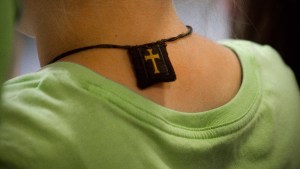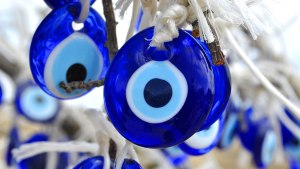Is the brown scapular some sort of “lucky charm” that superstitious Catholics like to wear?
At first glance the promises of the Blessed Virgin to St. Simon Stock appear to confirm suspicions. Our Lady’s famous words were,
Take, beloved son, this scapular of thy order as a badge of my confraternity and for thee and all Carmelites a special sign of grace; whoever dies in this garment, will not suffer everlasting fire.
It is the sign of salvation, a safeguard in dangers, a pledge of peace and of the covenant.
So based on this account, all I have to do is wear the brown scapular for the rest of my life and I won’t go to Hell. Bingo! Ticket to Heaven! Where do I get one?
Hold on there, fella. Getting to Heaven is never that easy.
First of all, let us remember what we should have learned in religion class. The brown scapular is categorized as a “sacramental” in the Catholic Church and works much differently than a “lucky charm.”
The Catechism explains:
Sacramentals do not confer the grace of the Holy Spirit in the way that the sacraments do, but by the Church’s prayer, they prepare us to receive grace and dispose us to cooperate with it.
CCC 1670
What this means is that a sacramental such as the brown scapular can dispose us to the graces God wants to give us, but we must respond to the invitation. Sacramentals are conduits of grace that only work if our end doesn’t have a cap on it.
Here is a story to illustrate: St. Claude de la Colombière once told of a man who tried to drown himself three times. Each time he was rescued against his will. Then he realized he was still wearing a brown scapular underneath his clothing. Determined to end his life, he ripped the scapular from his neck and was successful in the final attempt. God freely gave him the graces he needed and gave him the extra chances to turn to him, but the man remained obstinate in his ways and refused to cooperate. As a result, the Blessed Virgin Mary’s promise may have proven true, “whoever dies in this garment, will not suffer everlasting fire.”
St. John Paul II, himself a member of the Secular Carmelite Order, praised the wearing of the brown scapular, but warned against the superstitious wearing of it. He wrote in his Message to the Carmelite Community:
Therefore two truths are evoked by the sign of the Scapular: on the one hand, the constant protection of the Blessed Virgin, not only on life’s journey, but also at the moment of passing into the fullness of eternal glory; on the other, the awareness that devotion to her cannot be limited to prayers and tributes in her honor on certain occasions, but must become a ‘habit,’ that is, a permanent orientation of one’s own Christian conduct, woven of prayer and interior life, through frequent reception of the sacraments and the concrete practice of the spiritual and corporal works of mercy.
According to John Paul II, to secure our place in Heaven we can’t simply wear the brown scapular.
To put it more simply, the “habit” we wear must be based on a “habit” of prayer.
So the next time you put on a brown scapular, open your heart to God’s graces and Mary’s intercession. She wants to lead you to Heaven, but you can’t take the back seat and let her do all the work.



